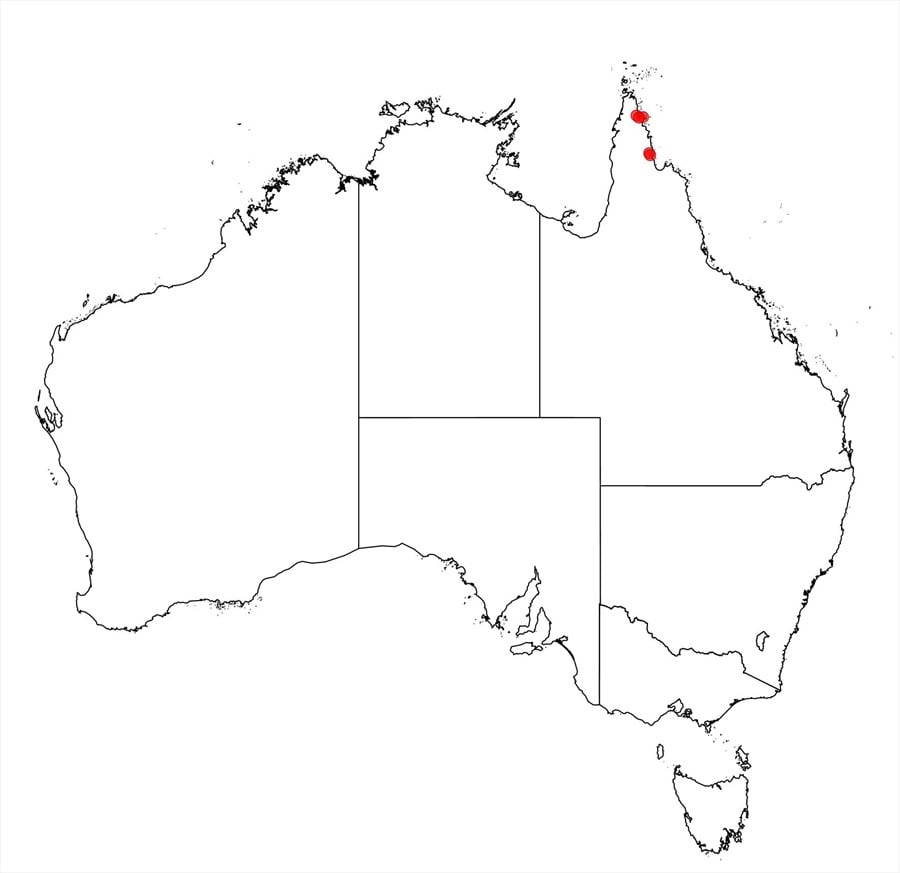Acacia rubricaulis Pedley
WATTLE
Acacias of Australia
Family
Fabaceae
Distribution
Restricted to the eastern coast of Cape York Pen., Qld, between about 11º and 14ºS.
Description
Shrub 2.5–6 m high. Branchlets acutely angled towards apex, often appearing polished when dry, dark red, stout, glabrous. New shoots and distal ends of developing phyllodes dark reddish brown. Phyllodes ovate or elliptic, straight and dimidiate or slightly falcate, 13.5–19 cm long, 22–42 mm wide, glabrous, 3 longitudinal nerves more prominent than the rest, free to the base or running together in the middle of the phyllode, secondary longitudinal widely spaced (1–1.5 mm apart) and openly and longitudinally anastomosing; gland usually inconspicuous, 0–5 mm above orifice small; pulvinus (5–) 7–9 (–12) mm long, dark red, polished. Inflorescences simple, 2 per axil; spikes 40–60 (–100) mm long, sub-densely flowered; receptacle variably pruinose, glabrous; peduncles 3–10 mm long, glabrous. Flowers 5-merous, perianth parts rather coriaceous; calyx gamosepalous, pruinose, very shortly and sinuolately lobed. Pods (immature) narrowly oblong, not constricted between seeds, 5–6 cm long, 7–8 mm wide, possibly to 10 mm when mature, flat, glabrous, obscurely nerved. Seeds (extremely immature) longitudinal, funicle thickened, expanded into an aril.
Habitat
Grows in sand on dune fields, degraded sand dunes and creek banks. Has been recorded once from the margin of rainforest.
Specimens
Qld: S of Harmer Ck, 37 km E of “Nixon” HS, J.R.Clarkson 9133 & V.J.Neldner (BRI, MBA n.v., PERTH n.v.); 10 km N of mouth of Olive R., J.R.Clarkson 9913 & V.J.Neldner (BRI, K n.v., PERTH n.v.); Round Point, Shelburne Bay, A.Gunness AG1923 (BRI).
Notes
According to L.Pedley (Austrobaileya 7(2): 354–356 (2006)) A. rubricaulis is a distinctive plant with obscure relationships. In B.R.Maslin (coordinator), WATTLE Acacias of Australia CD-ROM (2001) it keys to a group of species including A. crassa, A. cowleana and A. lamprocarpa but its widely spaced secondary nerves point to a relationship with A. leptocarpa. The stout, red, strongly angular, polished branchlets, pruinose spike-rachis, thick perianth parts and pod dimensions clearly distinguish it from all other species. Its pods resemble those of an undescribed Qld species, Acacia sp. (Castletower N.Gibson TOI345), which, however, has close parallel nerves similar to those of A. julifera Benth.
FOA Reference
Data derived from Flora of Australia Volumes 11A (2001), 11B (2001) and 12 (1998), products of ABRS, ©Commonwealth of Australia
Author
B.R.Maslin
This identification key and fact sheets are available as a mobile application:
URL: https://apps.lucidcentral.org/wattle/
© Copyright 2018. All rights reserved.







